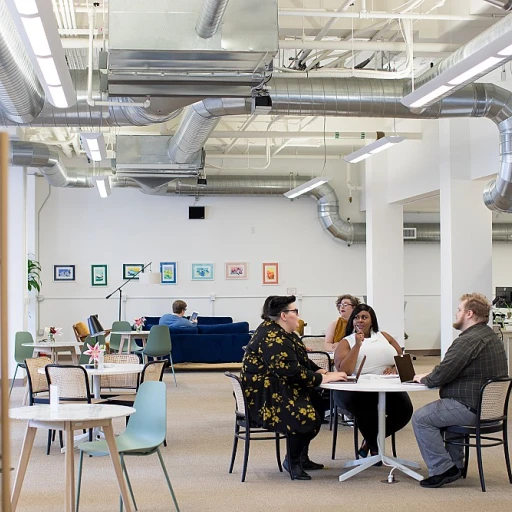Understanding the Skills Gap
What is the Skills Gap?
Ah, the elusive skills gap. It's like that missing puzzle piece that leaves HR scratching their heads and companies scrambling to find ways to fill it. Simply put, a skills gap is the difference between what employers need—and what job seekers offer. This mismatch can be a real buzzkill for businesses looking to stay competitive and for employees aiming to keep their careers on track.
Why It Matters:- For Companies: A company with unfilled skill gaps is like a car missing a few spark plugs: it's not going to run efficiently. Organizations facing these gaps can't operate at full throttle, impacting innovation, productivity, and ultimately, profits.
- For Employees: If you're feeling like your job skills might be stuck in second gear, you're not alone. The job market is shifting gears rapidly, and those who don’t keep pace often find themselves on the sidelines. Upskilling has never been more crucial.
The good news? Companies and employees alike are catching on that continuous learning and upskilling programs are the pit crew needed to keep the business and career engines running smoothly.
The Economic Impact
This isn't just about individuals or specific companies. The skills gap has a ripple effect across the economy. Filling these gaps can make a huge difference, like shifting gears on the economic highway; GDP could see a boost, and productivity could skyrocket.
A study from Deloitte reports that closing the skills gap could add trillions to the global economy. It's not just pocket change, folks. Check out how to
close the skills gap and steer towards a prosperous future.
Personal Experience and Strategies
Let’s bring a human touch to this. Take the story of Sarah, an HR manager at a medium-sized tech company. She noticed new hires were great on paper but lacked key soft skills. Sarah spearheaded skills training programs for both new and existing employees, focusing on communication and teamwork. The result? A shift in the workplace culture and a team more in tune with each other, boosting employee morale and job performance.
So, whether you’re an employee or running a business, identifying that skills gap and investing in learning can mean setting yourself up for a smoother ride down the road of career development and company success.
The Role of Continuous Learning
The Power of Continuous Learning
Continuous learning isn't just a buzzword; it's a necessity in today's fast-paced job market. Companies that invest in training programs not only close skills gaps but also boost employee morale and retention. Think of it as investing in your workforce's future, ensuring they're ready for the challenges ahead.
Employees today crave more than just a paycheck. They want opportunities for professional development and skill enhancement. By fostering a culture of continuous learning, organizations can meet this demand, keeping their workforce engaged and prepared for future work challenges. It's about creating an environment where learning is part of the everyday routine.
Why Continuous Learning Matters
Imagine a company that never updates its technology or processes. It would quickly fall behind its competitors. The same applies to employee skills. Continuous learning keeps skills fresh and relevant, bridging the gap between current capabilities and future needs. This is crucial for adapting to market changes and staying competitive.
Moreover, continuous learning helps in identifying skills in demand. Through regular gap analysis, companies can pinpoint where their workforce needs upskilling or reskilling. This proactive approach ensures that employees are always ready to tackle new challenges, making the business more agile and resilient.
Building a Learning Culture
Creating a culture of continuous learning requires commitment from both the company and its employees. It's about making learning opportunities accessible and appealing. This could be through formal training programs, online courses, or even informal knowledge-sharing sessions among employees.
Organizations that prioritize learning will find that their employees are more innovative and motivated. They see their job as more than just a task; it's a career with growth potential. This mindset shift can lead to increased job satisfaction and loyalty, which benefits both the employee and the company.
In the end, continuous learning is a win-win. Employees gain valuable skills that enhance their careers, while companies build a more capable and adaptable workforce. It's a strategy that pays off in the long run, helping businesses thrive in an ever-evolving job market.
Identifying Skills in Demand
Spotting the Skills Employers Crave
Identifying skills in demand is like putting together a puzzle. It's about figuring out which pieces will complete the picture and add the right colors to your team. Skills gaps can leave companies struggling, but there's a way to fix it. Companies need to understand what skills employees lack and what they should bring to the table.
First, there's the battle between hard skills and soft skills. Soft skills, like communication and teamwork, have proven to be essential in the workplace. They often go hand in hand with technical skills, which change as technology advances.
Next up is the job market. Trends are constantly shifting, and keeping up isn't easy. Businesses round up their teams by guessing what skills will become necessary. A good way to keep an edge is by conducting a gap analysis. This helps organizations to remain competitive and keep their workforce future-ready.
And don't forget about input from employees themselves. Who better to know the skills they need than the folks in the trenches? Employee feedback can shine a light on skills training and development needs.
Then there's the matter of reskilling and upskilling programs. Recognizing the need for these isn't enough; the real trick is in implementation. Training programs that focus on both current and future requirements create a culture of continuous learning. It's not an overnight process, but it sure pays off in boosting career progression and closing those pesky skills gaps.
In essence, identifying the skills in demand means being forward-thinking and adaptable. It's about recognizing the skills that drive your business today and anticipating the skills that will future-proof it tomorrow.
Implementing Continuous Learning in the Workplace
The Path to Lifelong Learning for Employees
Anyone who's been in the workforce for a while can tell you, skills don't just magically appear overnight. Especially when we're talking about closing skills gaps. It takes ongoing commitment. So, what can companies do to keep their team members' skills sharp? Let's dig into some practical strategies that bring continuous learning to your workplace.
One way to make learning stick is to create training programs that cater to everyone's level. Differentiated instruction isn't just for schools—it's for grown-ups too! Whether it's entry-level training or advanced skill development, tailoring sessions can make everyone feel included and invested in learning. Take time to identify skills necessary for each role, and the right programs to nurture those skills.
Next up, get creative with how you deliver that knowledge. Think online modules, workshops with industry experts, or even good old-fashioned mentorship programs. Mix it up and offer a bit of everything to keep things interesting and engaging.
Another tip: make it a routine. Just like brushing your teeth, learning should be a daily habit. Consider setting aside time for employees to focus on learning. It could be a dedicated 'Learning Hour' or 'Training Tuesday'. It sounds simple, but it’s an effective way to make learning part of the company culture.
Don't forget about feedback. Offering employees in-the-moment feedback on their skill progress helps them grow faster and aligns their learning with the business's goals. It's a win-win situation when the skills learned are directly applied and honed within their roles.
It's not always easy, but the effort is worth it. Continuous learning not only boosts employee skills but can rejuvenate a company’s growth and foster a positive work atmosphere. When the workforce feels prepared for future work, everyone thrives.
Challenges will arise—changing job markets, different learning paces, and more. Overcoming barriers is a topic for another day, but being proactive with this approach sets a solid foundation. Ready to embark on this learning journey? Wonderful! Start building a company where professional development is embedded in its core.
Overcoming Barriers to Continuous Learning
Push Through the Obstacles of Continuous Learning
You know that thrilling feeling after nailing a big presentation, right? Continuous learning in the workplace is somewhat similar. It's about upping your game, sharpening your skills, and prepping for the future work. Nonetheless, just like anything worthwhile, it comes with its own set of hurdles.
Firstly, time is a massive factor. Businesses often think there just isn’t enough of it to squeeze in learning programs amidst daily operations. Employees may feel their schedules are already jam-packed. That’s where efficiency steps in. Integrating employee skills training into existing workflows can help. Make it feel like part of the job rather than an additional chore.
Next up is funding. Continuous learning can often seem like a pricey venture for companies. But here's the rub—it’s an investment, not a cost. Skill development is like vitamin shots for your business; it might sting initially, but your workforce becomes healthier and more competent. Eager companies are adopting solutions such as online training programs and partnerships with educational platforms to close skills gaps economically.
Then, let's chat about motivation. It may be low for employees who don’t see a direct benefit. Companies should link learning to career growth. Clear pathways and skill gaps analysis help employees see how learning new skills can lead to promotions and better job roles.
Lastly, not forgetting soft skills. While everyone talks about the technical side, soft skills like communication and teamwork face a reluctance in training. But they are crucial for fostering collaboration and leadership in any organization.
In a nutshell, it’s not always smooth sailing, but with persistence and clever strategies, businesses can power through these barriers. And when the dust settles, you have a motivated, dynamic team ready to take on any challenge the future job market throws their way.
Measuring the Impact of Continuous Learning
Tracking Continuous Learning Outcomes and Progress
The benefits of continuous learning in closing skill gaps are vast, but how do businesses ensure these efforts truly pay off? Measuring the impact of continuous learning isn’t just a nice-to-have; it's essential for both accountability and growth. Let's break down how organizations can evaluate their training programs and learning initiatives.
One effective approach is to establish key performance indicators (KPIs) related to employee skills development. By tying learning objectives to specific business goals, companies can track progress and adjust strategies as needed. For instance, is there a noticeable increase in productivity or job performance linked to specific training programs? Are the skills gained translating into real-world applications?
Incorporating feedback from employee performance reviews can also provide insights into the effectiveness of upskilling and reskilling initiatives. Employees themselves are invaluable sources of information—they're the ones experiencing these programs firsthand. Anonymous surveys can shed light on how skills training impacts daily responsibilities and whether employees feel more equipped to meet job demands.
There’s also the matter of retention. Companies investing in employee development often see reduced turnover rates. A workforce engaged in continuous learning is likely more satisfied and motivated, fostering a culture of growth within the company.
Organizations should also monitor post-training success rates by analyzing how employees apply new skills. Are they moving into new roles, tackling more complex projects, or achieving certifications that enhance their career paths? Furthermore, tracking these outcomes helps identify skills gaps that remain, guiding future skill development endeavors.
Consider tools like learning management systems (LMS) that offer analytics and reporting capabilities. These tools can streamline the measurement process, giving companies a clear picture of how learning initiatives impact performance across the board.
Ultimately, by evaluating the outcomes of continuous learning, companies can ensure their strategies not only bridge the gap but also drive sustained business success, empowering employees to meet the future of work with confidence.






